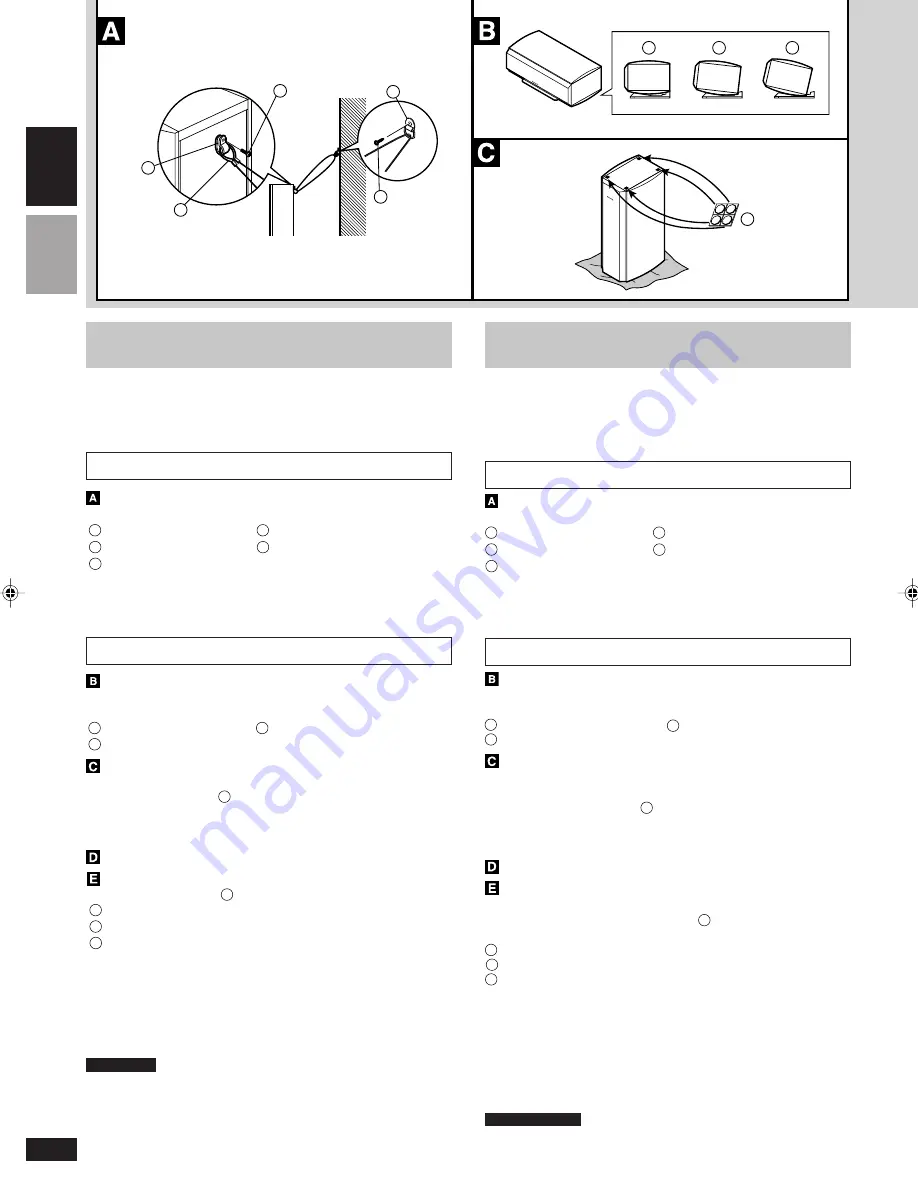
RQT7806
4
ENGLISH
ESP
AÑOL
a
b
c
d
e
f
g
h
i
Remove the speaker net. Take care not to apply undue pressure
to the front nets when handling the speakers. Lay the speakers
on a flat surface over a soft cloth when working on them.
Tighten the screws firmly.
Speaker setup
Front speaker (SB-PF800)
Attaching a stabilizing wire
Example
Nylon clamp
Screw for nylon clamp
Wire (not included)
Ring (not included)
Screw (not included)
Screw the wood screw into a thick and hard part of the wall.
The surface must be able to support over 40
kg
.
The stand base cannot be removed.
a
c
e
b
d
Supplied stand for center speaker (SB-PC800)
The angle of the center speaker to the stand can be adjusted as
indicated below.
Speaker and stand level
Speaker facing slightly upwards
Speaker facing further upwards (Angle: approximately 12.5°)
Attaching the rubber feet when placing on a surface
Surround (SB-PS800), surround back (SB-PS800A) speakers
Attach the rubber feet
i
to the base of the speaker to prevent
vibration from causing the speaker to move or fall over.
g
f
h
Attaching to a wall
Center speaker (SB-PC800)
Surround (SB-PS800), surround back (SB-PS800A) speakers
Attach four rubber feet
i
to the rear of the speaker.
Screws (not included) 35 mm or longer
Screws (4 per speaker)
Metal wall mounts (2 per speaker)
Screw the wood screw into a thick and hard part of the wall.
The surface must be able to support over 30
kg
.
• Use wall strengtheners and screws that can adequately bear
the weight of the speaker. Seek advice from a qualified person.
• As this speaker has a bass reflex port on the rear, attaching it
to a wall can affect bass output.
j
k
l
CAUTION
Do not attempt to attach these speakers to walls using methods
other than those described in these operating instructions.
Center, surround, surround back speakers
Retire la red de los altavoces. Tenga cuidado cuando maneje los
altavoces para no aplicar una presión excesiva a las redes
delanteras. Coloque los altavoces en una superficie plana y encima
de un paño blando cuando tenga que hacer algo con ellos.
Apriete firmemente los tornillos.
Instalación de los altavoces
Altavoz delantero (SB-PF800)
Colocación de un alambre estabilizador
Ejemplo
Abrazadera de nailon
Tornillo para abrazadera de nailon
Alambre (no suministrado)
Anillo (no suministrado)
Tornillo (no suministrado)
Atornille el tornillo para madera en una parte gruesa y dura de la
pared. La superficie deberá poder servir de apoyo a más de 40
kg
.
La base del soporte no se puede quitar.
Soporte suministrado para altavoz central (SB-PC800)
El ángulo del altavoz central al soporte se puede ajustar como lo
indicado a continuación.
f
Altavoz y soporte nivelado
Altavoz mirando hacia arriba
h
Altavoz mirando más hacia arriba (Ángulo: 12,5° aproximadamente)
Colocación de las patas de goma cuando los
altavoces se ponen encima de una superficie
Altavoces ambientales (SB-PS800) y ambiental trasero (SB-PS800A)
Coloque las patas de goma
i
en la base del altavoz para impedir
que las vibraciones desplacen el altavoz o hagan que éste se caiga.
Colocación en una pared
Altavoz central (SB-PC800)
Altavoces ambientales (SB-PS800) y ambiental
trasero (SB-PS800A)
Coloque las cuatro patas de goma
i
en la parte trasera del
altavoz.
j
Tornillos (no incluidos) de 35 mm o más largos
k
Tornillos (4 por altavoz)
l
Piezas metálicas para montaje en pared (2 por altavoz)
Atornille el tornillo de madera en una parte gruesa y dura de la pared.
La superficie deberá poder servir de apoyo a más de 30
kg
.
• Utilice reforzadores de pared y tornillos que puedan aguantar
adecuadamente el peso del altavoz. Solicite consejo al
personal cualificado.
• Como este altavoz tiene un orificio de reflejo de graves en la
parte posterior, colocarlo en una pared puede afectar a la
salida de los sonidos graves.
PRECAUCIÓN
No intente colocar estos altavoces en paredes siguiendo métodos
distintos de los descritos en estas instrucciones de funcionamiento.
Altavoces central, ambientales y ambiental trasero
a
c
e
b
d
g





























